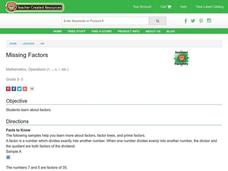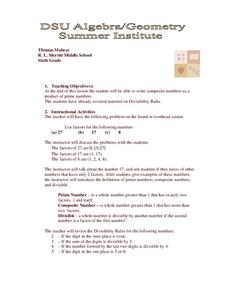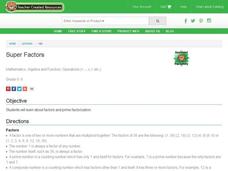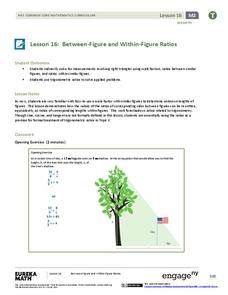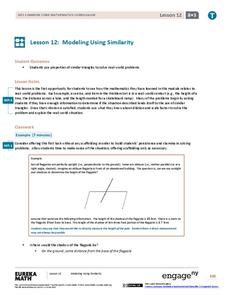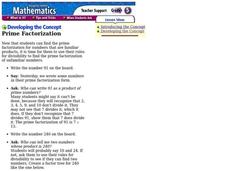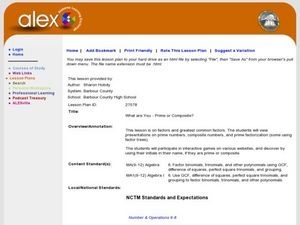EngageNY
Least Common Multiple and Greatest Common Factor
Find the common denominator between prime factors, factor trees, and the distributive property. Scholars learn to find the least common multiple and greatest common factor of pairs of numbers. They rotate through stations to connect...
Illustrative Mathematics
How Many Leaves on a Tree?
This is great go-to activity for those spring or fall days when the weather beckons your geometry class outside. Learners start with a small tree, devising strategies to accurately estimate the leaf count. They must then tackle the...
Willow Tree
Factoring Polynomials
Young mathematicians discover trees organize more than just families — they help factor, too. The lesson begins with factor trees and develops slowly to factoring by grouping and special patterns.
Curated OER
Prime Factorization: Finding Factors in the Fifth Grade
The lesson starts out with a brain drain, which is a great way to get students to activate prior knowledge and build lasting connections. They tell everything they know about prime factorization, use their knowledge to...
Curated OER
Missing Factors
Students explore factors. They discuss factors, factor trees and prime factors. Students practice working with and finding various factors and prime factors. They discuss methods used to find factors.
Curated OER
Prime Numbers and Factors
Solving factor trees is a helpful way to introduce prime numbers. Your math class practices using this method along with two-column tables to find if a number is prime or not. They also learn other vocabulary, such as composite numbers,...
Curated OER
Greatest Common Factor: Using the Factor Tree
Students find the greatest common factor of two numbers. In this algebra lesson, students use prime factorization to find their factor to simplify equations. they create a factor tree to find the factors of composite numbers.
Alabama Learning Exchange
How Old Is That Tree?
Fifth graders study environmental changes by examining the annual rings of a cross-section of a tree trunk. They access websites to complete a worksheet on the parts of a tree. They count the annual rings on a tree slice while observing...
Curated OER
Super Factors
Students complete activity pages. In this factors lesson, students practice finding the factors of numbers. They discuss prime factors and prime factorization and learn how to complete a factor tree.
Curated OER
Abiotic and Biotic Factors
Students examine abiotic and biotic factors. They define biotic and abiotic, categorize a list of items onto a Venn diagram, label various items from areas on the school grounds as biotic or abiotic, and diagram a magazine picture.
Curated OER
Super Size It, Please!
Pupils take photos from a given distance and determine the height of the person using a scale factor. Pupils calculate the ratio of student actual height to student photo height. They take pictures from 3 different distances to see if...
EngageNY
Between-Figure and Within-Figure Ratios
Tie the unit together and see concepts click in your young mathematicians' minds. Scholars apply the properties of similar triangles to find heights of objects. They concentrate on the proportions built with known measures and solve to...
Curated OER
Chocolate Math
Students practice solving math equations by analyzing chocolate recipe measurements. For this chocolate baking math lesson, students read about the Hershey factory and recipes used to create chocolate bars. Students solve problems and...
Curated OER
Transition to algebra
Students recognize the difference between a prime and a composite number. In this prime and composite number lesson, students use a factor tree model to show prime factorization. Students participate in a bingo activity....
Curated OER
Prime Time
Seventh graders practice determining the prime factorization of composite numbers. They create Christmas factor trees for prime numbers greater than 100. They decorate their final products with markers, crayons, colored pencils, glitter...
Curated OER
Prime & Composite Numbers: Algebra/Geometry Institute 2009
Students create factor trees. In this prime and composite lesson, students model fractions using tiles. They create factor trees and identify prime and composite numbers. Students use grid paper and tiles to model...
EngageNY
Modeling Using Similarity
How do you find the lengths of items that cannot be directly measured? The 13th installment in a series of 16 has pupils use the similarity content learned in an earlier resource to solve real-world problems. Class members determine...
Curated OER
Extraordinary Extrapolation
Students study how scientists have estimated the maximum height to which trees can grow, and assess the reliability of interpolation and extrapolation techniques by making predictions with particular data sets and analyzing accuracy of...
Curated OER
Prime Factorization
Sixth graders participate in a lesson that focuses on the concept of finding the prime factorization of a number. They write the answer using exponential notation. Students play a game of Bingo to keep engaged during the lesson.
Curated OER
Prime Factorization
Students work with prime numbers. In this prime factorization lesson, students review writing numbers in their prime factorization form and solve multiple problems.
Curated OER
The Fair Factor
Students participate in playing many games to determine if they are fair or not. They create their own game that is fair to play with their classmates.
Curated OER
What Are You - Prime or Composite
Students explore the concept of prime factorization. In this prime factorization activity, students participate in an activity where they find the prime factorization and greatest common factor of a number derived from their name....
Curated OER
Trees For Trout!
Fourth graders determine the impact of native forests, local clearcuts and local clearcuts and local reforestation projects on the survivablity of Rainbow Trout in their area. They record and document the stages of the trout throughout...
Curated OER
Carrying Capacity of Ecosystems
Students define population and carrying. In this algebra lesson, students explore exponential growth and decay based on animals and things that grow or decrease exponentially. They graph their findings and discuss their results as they...




